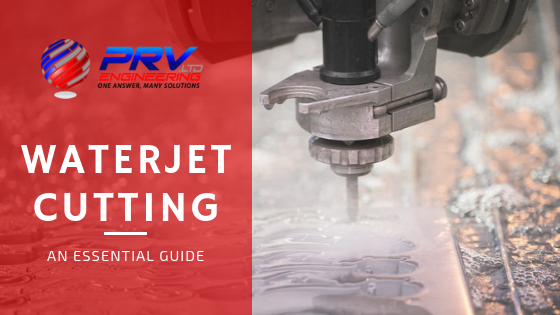
The evolution of hydro-abrasive waterjet cutting has been remarkable and is one of the most effective methods of machining. There is no heat affected zone (HAZ), the small cutting widths and omni-directional cutting means we can machine virtually any material with high precision and accuracy. As a result, waterjet cutting produces a much-improved product finish with little to no secondary processing needed.
Advanced technology and methods make waterjet cutting far more environmentally friendly. So much so that the dust, chippings or gas produced with other cutting methods do not occur. There is also no need to change tool heads, blades or lubricants for each type of material which means machining time is greatly reduced.
This highly versatile cutting method produces much less waste than other forms of cutting which allows for more diverse design. The ability to cut more intricate designs and patterns offers designers a more artistic license. Let us take a look at how this process works along with some added benefits.
How Does Waterjet Cutting Work?
Waterjet cutting is often used during fabrication of machine parts and is commonly used in mining and aerospace for cutting, shaping and reaming. It can cut a thickness of 1mm to 150mm in various sizes from the most intricate up to a 4m x 2m profile. Waterjet cutting is incredibly accurate – 0.005 in. with a repeatability of 0.001 in. over the entire process.
Waterjet cutting machines have water pumps to supply water at 60,000 Psi to twin cutting heads. At the cutting head, pressurised water is forced through a diamond, ruby or sapphire opening of 0.254 in diameter. An abrasive material is added to help cut tougher metals where the nozzle directs the jet onto the material at approximately three times the speed of sound.
The basic components of a waterjet cutting machine include the following:
- High pressure pump – generates flow of pressurised water
- Articulated cutting head – computer controlled 5-axis cutting head allows for angled cuts
- Abrasive waterjet nozzle – The ability to cut materials is obtained by pressurising water to extremely high levels and then feeding that water stream through a small orifice. From there it passes through a section where a measured amount of abrasive is added. This mixture results in a coherent stream of abrasive particles traveling at a very high speed.
- X-Y Motion system – accurately moves the nozzle to create the desired cutting path
- Digital CNC communication with remote push-button panel
- Electronic hopper for abrasive automatic monitoring with sensors for cutting parameters and automatic control
- PC Controller – advanced motion controllers are PC based and allows for even inexperienced operators to use effectively
Here is a more detailed explanation on exactly how the waterjet process works.
Benefits Of Waterjet Cutting
There are countless benefits to using waterjet cutting including the ability to cut heat-sensitive material. This eliminates the risk of adding material stresses generally associated with thermal metal cutting. Hydro-abrasive waterjet cutting machines can cut nearly any type of material like glass, plastic, wood, rubber and obviously metal.
Advanced software is improving the usability experience with a user-friendly CAD/CAM interface compatible with nearly all file formats. Modern software design is also playing a major role in simplifying the integration of waterjet technology into standard production. More engineering shops are implementing waterjet technology as a cost-effective, complementary machining method to cut parts to near-perfect requirements. This greatly aids in minimising waste, maximising raw material usage and accelerates overall production.
In most cases, the omni-directional cutting ability means that no drill holes are required at starting points. This makes cutting of sharper corners and curves much easier. Traditional cutting and milling machines manufacture square shapes with a cutter, leaving a radius in the corner which often requires re-machining. Waterjet cutting removes the need for multiple sessions while reducing the total production time. No further finishing actions are required once the cutting is complete.
What materials can you cut using hydro-abrasive waterjet machines?
Heat can affect composite materials when using other cutting methods. Each composite element reacts differently resulting in the weakening of the overall material structure. This does not occur with water jet cutting as there is no heat affected zone. All sorts of composites such as carbon fibre reinforced plastics, glass reinforced plastics and other composites can be machined.
While waterjet cutters can machine most glass, the only exception is tempered glass. It is too fragile for any machining process and will shatter if cut or broken. Softer materials like rubber and plastic can also be cut to highly accurate specifications. Stone and concrete are great examples where finished products include wall panels, counter tops and patterned floor stones and tiles. In fact, various structural and architectural items are cut using this technology.
As a result of no heat affected zone (HAZ), there is a long list of metals ideally suited for waterjet cutting. While some of the prominent metals include aluminium, copper and brass, we cut even the more exotic alloys such as monnel, inconnel, hastalloy and titanium.
In the coming years, abrasive waterjet cutting will move even further into digital connectivity and the Industrial Internet of Things (IIOT). With Internet-connected machines, future abrasive waterjet systems will have more forward-thinking features and functionality.
At PRV Engineering, our state-of-the-art Idroline S1730 hydro-abrasive waterjet cutting system ensures superior technological and productive performance. Get in touch with our team of experts if you need help with your project or if you have any questions about our precision engineering one-stop facility.
This site uses Akismet to reduce spam. Learn how your comment data is processed.


 Mail:
Mail: 




Leave a Comments